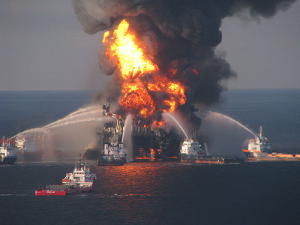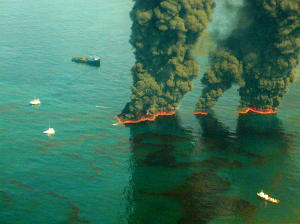Is offshore oil development safe?
Up to May 28, 2010, this disaster has triggered:
 The death of 11 people
The death of 11 people- The burning then the sinking of the oil rig worth 560 million USD on April 22
- The leakage of 2 to 3 million liters of oil per day from a field located at 1525 meters beneath the sea
- The pouring of more than 84 million liters of oil in the ocean, that is, approximately 527 000 barrels
- The closure of 22% of the American territorial waters in the Gulf of Mexico
- A loss in the company British Petroleum (BP) stock value by 42 billion USD
Apart from dirtying Louisiana, Alabama and Mississippi, the oil slick is likely to progress along the Gulf's coasts of Florida destroying the region's fragile ecosystem.
British Petroleum (BP), which is using the oil rig, is held responsible for this disaster. It is required to pay a bill comprised between 2 to 4 billion USD, according to Fitch Rating's estimate, and no less than 8 billion USD according to the New Yorker broker Sanford Bernstein & Co.
As to the total cost which includes the liability of other stakeholders like Transocean, the American company owner of Deepwater Horizon or Cameron and Halliburton, the American subcontractors, entrusted with the oil rig and fields' consolidation, it is estimated by the Credit Suisse at about 18 billion USD.
By May 28, 2010, the costs of the measures undertaken by BP to combat the oil slick, stop the leak and indemnify the victims would amount to 930 million USD.
Very present in the Gulf of Mexico, the oil company BP detains there assets worth 37 billion USD according to Deutsche Bank.
The insurers loss bill
 Controlled burns of the Deepwater Horizon oil spill Controlled burns of the Deepwater Horizon oil spill |
Most of the bill will be supported by Jupiter Insurance Ltd, a captive of the oil group BP, as well as by some reinsurers. Swiss Re has evaluated reinsurers' exposure between 1.5 and 3.5 billion USD.
According to provisional estimates, Munich Re has posted a potential loss over 128 million USD, Hannover Re 51 million USD, Partner Re 76.6 million USD, while Transatlantic Re's losses would amount to 15 million USD. Scor, on its part, has assessed its potential exposure at less than 6.4 million USD whereas Swiss Re evaluated its participation at 200 million USD.
Transocean has to cover not only the 560 million USD of the oil rig, which is buried underneath the ocean, but also the extraction fees and the wreck clearance.
On its part, Oil Spill Liability Trust Fund, an indemnification fund which withholds eight cents (0.08 USD) per barrel produced or imported to the United States, is set to contribute in the indemnification of the victims. Set up in 1990 following the Exxon Valdez shipwreck, this entity is endowed with 1.6 billion USD designed to cover damages triggered by hydrocarbon pollution.
The Gulf of Mexico counts 4000 oil rigs which ensured in 2009 more than 30% of American oil production, that is, 1.7 million barrels per day, mainly from deep waters versus 11% in 1990.
The offshore exploitation of fossil resources in this area has become a crucial stake in the American energetic strategy.